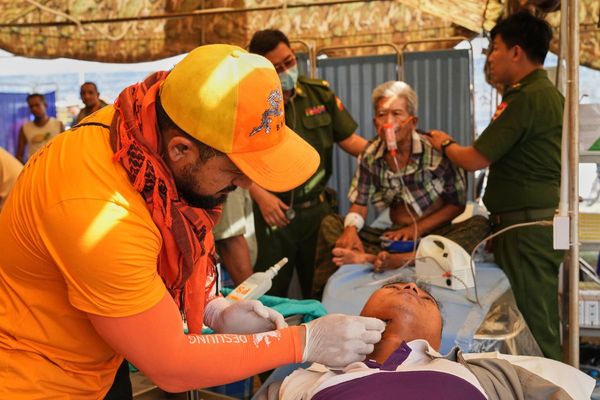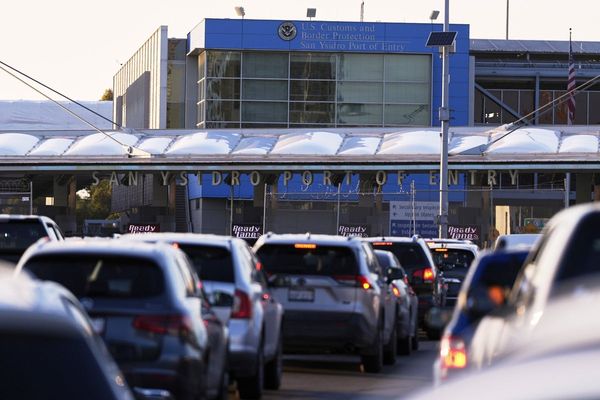
For years, the lustrous copper and glass necklace was on display at the Royal Museum for Central Africa in Tervuren, east of Brussels. Reputed to have belonged to a notorious 19th-century trader of enslaved people, it has 10 bright gilded copper beads suspended on silk, with red glass “jewels” on an intricate medallion. But nobody really knew how the jewellery from central Africa came to be in Belgium.
The museum first registered the necklace in 1959. A decade earlier, a Greek resident of the former Belgian Congo tried unsuccessfully to sell it to the museum. He had acquired it from an anonymous Belgian mechanic, who in turn had bought it from a Congolese chief – or so the archives said.
That simple story hides a much more complicated and violent reality. The necklace belonged to Yakaumbu Kamanda Lumpungu, chief of the Songye people in Kabinda in the centre of the modern-day Democratic Republic of the Congo (DRC).
A proponent of Congolese independence, Lumpungu was hanged in 1936 by the colonial administration, accused of a double murder – charges that his family denies. Lumpungu had inherited the necklace from his father and gave it to his favourite wife, Mfute. His relatives do not believe he would have parted with it voluntarily.
Nearly 90 years after his death, the necklace is one of dozens of objects on display in an exhibition on the provenance of the collection of the Royal Museum for Central Africa, which runs until 29 September. The museum was rebranded as the AfricaMuseum in 2018 after a massive renovation and “decolonisation” process.
Today, the museum – founded in 1898 to glorify a brutal colonial project – is still coming to term with its past. After King Léopold II took control of Congo in 1885, establishing a notoriously violent and cruel regime, thousands of objects – art, weapons, musical instruments, grave goods and even human remains – flowed north to Brussels.
The AfricaMuseum – like the British Museum in London, the Musée du Quai Branly in Paris and Hamburg’s Museum am Rothenbaum – Cultures and Arts of the World – is grappling with growing calls for restitution of colonial-era artefacts.
Bart Ouvry, director of the AfricaMuseum, said: “In the long term, it is inevitable that a number of those objects go back or at least become the property of the Congolese government.” He added: “We don’t have a right to fail.”
Ouvry, who was the EU’s envoy to the DRC, Kenya and Mali, said restitution would “take decades” to complete but he would be “disappointed if we haven’t taken any concrete steps during my mandate”, which has a further five years to run.
The museum is not the arbiter of what to return, however, as the collection officially belongs to the Belgian state. In the wake of the Black Lives Matter protests, which forced a reckoning with the country’s colonial past, Belgium passed a law in 2022 on the restitution of colonial collections.
The legislation allows objects, in particular those acquired under duress or through violence, to be returned after research by historians to the DRC, Rwanda or Burundi (other Belgian colonies) through treaties with those states.
Until very recently, it was thought that “probably around 1,000 objects [at the AfricaMuseum] were taken away in the context of violence”, said Hein Vanhee, a historian at the museum. “We now know that is a serious underestimate.”
His meticulous trawl of the archives has found that more than 40,000 objects – about one-third of the entire collection - were collected before the first world war, the most violent period in Belgium’s colonial history. Under Léopold II’s Congo Free State, which ended in 1908, colonial forces shot, and severed the hands of, people who failed to meet rubber quotas. The Belgian government took over the colony until 1960.
“Many more [objects] than we would like to think, in the past, were collected in the context of violence,” Vanhee said, although poor documentation made it impossible to be precise. About one-fifth (22%) of the 40,000 objects came to Belgium with no information.
But it is clear that thousands of artefacts were collected by force during punitive expeditions. One Belgian officer, who supplied a cache of objects, reported back that local language names of items could not be recorded “given the state of hostility of the Babanga people”.
The Compagnie du Kasaï, a rubber trader established in 1901 and long controlled by Léopold II, made regular deliveries to the museum, including one consignment of 1,400 objects in 1913. The archives are silent on how the objects were acquired.
Today, restitution is not so simple. Anne Wetsi Mpoma, a Brussels-based curator who runs a gallery dedicated to African art and culture, argues that the 2022 law is “unrealistic”, in part because it puts the emphasis on a Congolese government already “not doing its job”, she said, in basic functions such as health or security.
She added: “When the Congolese government receives those objects, what will they do with them? Will they give them back to the communities? Or will they put them into museums?”
Rather than a state-to-state restitution programme, she proposes a grassroots-led approach where Belgian museums and the Congolese diaspora work with African museums and local communities to transfer works.
“There is also real work that needs to be done in the field, to [say to] communities: ‘OK, are you willing to receive those objects back? Do you even know that those objects are being held in white institutions in Belgium?’”
Meanwhile, the AfricaMuseum is revising its own displays. Since the 2018 reopening, busts of colonial-era figures and a controversial “Leopard Man” sculpture have been moved from the grand entrance to a storeroom where they can only be seen as part of a guided tour.
Museum staff had intended a “dialogue” between the colonial-era pomp and newly installed works by modern African artists, but most visitors saw only the old propaganda unvarnished.
“Of course, it is a process,” Ouvry said, referring to the museum’s renovation. “If there is one museum in Belgium which cannot afford to remain in its ivory tower, it is certainly the AfricaMuseum.”







